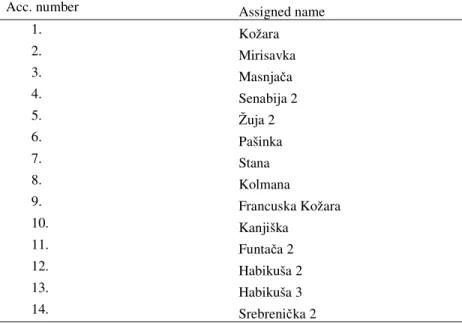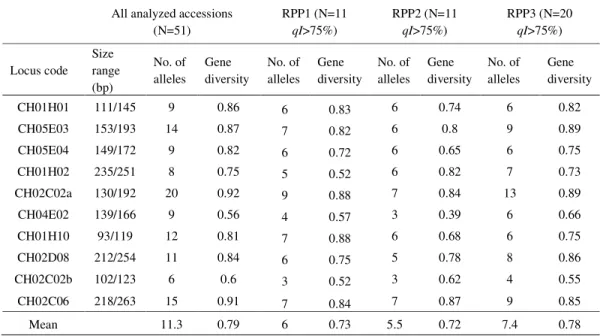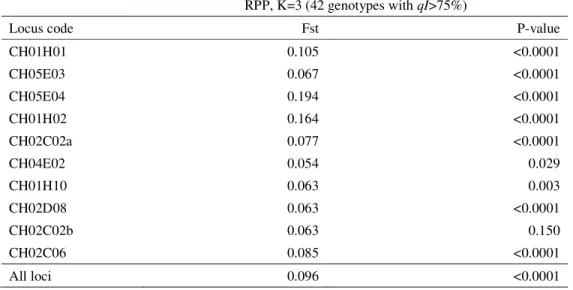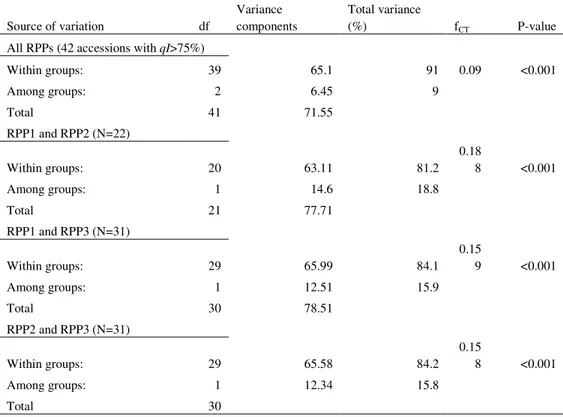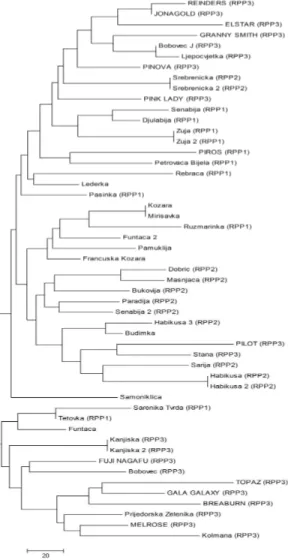___________________________
Corresponding author:Fuad Gasi, PhD; Faculty of Agriculture and Food Sciences, University of Sarajevo, Zmaja od Bosne 8, 71000 Sarajevo, Bosnia and Herzegovina. Telephone number: +387 33 653 033; Fax number: +387 33 667 429; E mail: fudo01@yahoo.com.
UDC 575 DOI: 10.2298/GENSR1302467G
Original scientific paper
GENETIC STRUCTURE OF APPLE ACCESSIONS MAINTAINED EX SITU IN BOSNIA AND HERZEGOVINA EXAMINED BY MICROSATELLITE MARKERS
Fuad GAŠI1, Maja ŽULJ MIHALJEVI 2, Silvio ŠIMON2, Jasmin GRAHI 1, Naris POJSKI 3 Mirsad KURTOVI 1, Dragan NIKOLI 4, Ivan PEJI 2
1 Faculty of Agriculture and Food Sciences, University of Sarajevo, Sarajevo, Bosnia and
Herzegovina
2Department of Plant Breeding, Genetics and Biometrics , Faculty of Agriculture, University of
Zagreb, Zagreb, Croatia
3Laboratory for molecular genetics of natural resources, Institute for Genetic Engineering and
Biotechnology, Sarajevo, Bosnia and Herzegovina
4Institute for fruit science and viticulture, Faculty of Agriculture, University of Belgrade,
Beograd – Zemun, Serbia.
Gaši F., M. Žulj Mihaljevi , S. Šimon, J. Grahi , N. Pojski , M. Kurtovi , D.Nikoli and I. Peji (2013): Genetic structure of apple accessions maintained ex situ in Bosnia and Herzegovina examined by microsatellite markers. Genetika, Vol 45, No. 2, 467-478.
introduced at a later date. Cluster analyses also enabled the detection of one synonym and three homonyms within the collection. In four cases, previously conducted identification based on phenotypic analyses was confirmed by genetic analyses. Results of the structure analyses indicate a heterogeneous genetic structure of the analyzed accessions. This characteristic of the B&H apple germplasm could be useful for future breeding programs.
Key words: traditional apple cultivars, SSR, factorial correspondence analyses, Bayesian analyses
INTRODUCTION
With the aim of conserving fruit genetic resources in Bosnia and Herzegovina (B&H) an apple and pear ex situ collection was established in Srebrenik (northeast Bosnia), in year 2000. Accessions maintained at the collection were gathered from a wide range of locations in Bosnia and Herzegovina. During the collecting missions, a large set of traditional knowledge, including cultivar names, for many of the genotypes was also gathered from farmers maintaining the apple and pear trees. However, in some cases the names obtained from the farmers were descriptive in nature and generally unreliable. Alongside the collected B&H apple germplasm, in 2001 fifteen international, commercial apple cultivars were planted within the ex situ collection in Srebrenik. These genotypes have in mean time been regularly used as reference cultivars in studies on the B&H traditional apple germplasm. Results of phenotypic analyses carried on both traditional and reference materials indicate a significantly higher diversity for all morphological traits within the B&H traditional apple germplasm (GASI et al., 2011). Observed phenotypic data, especially pomologic, was used for the identification of accessions for which the curators did not obtain reliable names during the collecting mission. However, a recent review by NYBOM and
WEISING (2010) reports that DNA markers reveal much higher number of mislabeled plant
accessions (typically 25–30% mislabeling) when compared to traditional pomological characterization (typically 5–10% mislabeling). Aside for correct identification of the accessions, genetic markers can assist in the assessment of the genetic diversity of a certain apple germplasm (MARI et al., 2010) as well as to evaluate commercial traits such as ethylene production in apple
fruit (MARI et al., 2005; 2007). Among a large number of different DNA molecular markers, Simple Sequence Repeat (SSR) markers, also known as microsatellites, due to their abundance, reproducibility and polymorphism are highly useful (NYBOM and WEISING, 2010), especially for examining genetic diversity. Microsatellites have previously been used for genetic assessment of 24 traditional and 13 international apple accessions maintained at the ex situ collection in Srebrenik (GASI et al., 2010). Traditional accessions selected for genotyping in that study were some of the best known old B&H cultivars, for which the curators found and documented large amounts of traditional knowledge. SSR markers have also been used to examine the genetic structure of B&H apple germplasm found on farms in Bosnia and Herzegovina (GASI et al.,
2013). Similar studies on genetic structure of local apple germplasm maintained on farm and ex situ have previously been carried out by PEREIRA-LORENZO et al. (2008) and URRESTARAZU et al.
(2012) in Spain.
the ex situ collection in Srebrenik, to a database constructed for previously characterized 37 traditional and international apple cultivars from the same collection using a set of 10 SSR markers and 2) to examine the genetic structure of 51 apple accessions maintained ex situ in Bosnia and Herzegovina.
MATERIALS AND METHODS
A total of 14 traditional B&H apple accessions (Table 1) maintained at the ex situ collection in Srebrenik were genotyped with a set of 10 SSR markers, previously used by GASI et al. (2010) on 37 selected apple accessions (24 traditional and 13 international, reference cultivars) from the same collection. Unlike the previously characterized 24 traditional apple accessions, whose names were gathered during the collecting missions from the farmers cultivating them, 14 apple accessions analyzed in this study have been assigned names based on a morphologic identification conducted by curators of the collection.
Table 1. Fourteen apple accessions maintained at the ex situ collection in Srebrenik analyzed in this study using 10 SSR markers. Accessions names assigned based on a morphologic identification conducted by curators of the collection. In cases where the same genotyped has already been registered within the collection, a number two or three is added to the name of the supposed synonym.
SSR analyses
Tissue samples for DNA analyses were collected in the spring of 2011, from a single tree for each accession. DNA extraction was performed with Qiagen DNeasy® Plant Mini Kit (Qiagen, Valencia, California, USA) according to the protocol included in the kit. Ten primer pairs used for SSR amplifications have been previously published by GIANFRANCESCHI et al.
Acc. number Assigned name
1. Kožara
2. Mirisavka
3. Masnja a
4. Senabija 2
5. Žuja 2
6. Pašinka
7. Stana
8. Kolmana
9. Francuska Kožara
10. Kanjiška
11. Funta a 2
12. Habikuša 2
13. Habikuša 3
(1998) and LIEBHARD et al. (2002). PCR amplification of SSR sequences was performed in a Veriti TM Thermal Cycler (Applied Biosystems, Foster City, California, USA) using fluorescent labeled primers, which enabled the detection of PCR products using ABI 3130 Genetic Analyzer (Applied Biosystems). All PCR amplifications were performed as described in GIANFRANCESCHI
et al. (1998). The PCR product was diluted with ddH20 (1:50), then added to 8.75 l HiDi and 0.25 l Genescan 500 LIZ size standard. Obtained data was analyzed using the software package GeneMapper 4.0 (Applied Biosystems).
Biostatistical analyses
SSR profiles obtained by genotyping 14 accessions from the ex situ apple collection in Srebrenik were added to the existing microsatellite database constructed in a previous study on apple accessions maintained at the same collection.
Population genetics software SPAGeDI 1.2 (HARDY and VEKEMANS, 2002) was used for calculating allele frequencies, gene diversity (NEI, 1978) and Fst (WEIR and COCKERHEIM, 1984). Analyses of molecular variance (EXCOFFIER et al., 1992), based on the stepwise mutation model (OHTA & KIMURA, 1973), was performed using GenoType software with 1000 permutations. Genetic distance between accessions (BRUVO et al., 2004), based on a two-phased mutation model (DI RIENZO et al., 1994) was calculated using GenoDive software. Both programs are part of the GenoType/GenoDive package (MEIRMANS and VAN TIENDEREN, 2004).
In order to examine population structure we used the Bayesian model-based cluster procedure within STRUCTURE version 2.2.3 (PRITCHARD et al., 2000). Method described by EVANNO et al. (2005) was used to estimate the most probable K value for the analyzed data. This
was done through Structure harvester ver. 0.6. application (EARL and VONHOLDT, 2011).
Assignment of one cultivar in a RPP (reconstructed panmictic populations) was provided by a probability of membership qI chosen at 75%.
Neighbor-joining cluster analysis, based on the above mentioned genetic distance was performed in MEGA 5 software (Molecular Evolutionary Genetics Analysis), (TAMURA et al., 2011). A multivariate analyses, FCA (factorial correspondence analysis) based on allele frequencies was performed using Genetix 4.02 (BELKHIR et al., 2001), which meant excluding the triploid genotypes.
RESULTS AND DISCUSSION
SSR polymorphism
Overall, ten SSR primer pairs amplified 113 alleles or on average 11.3 alleles per analyzed loci (Table 2). Compared to the previous study on selected apple genotypes maintained at the ex situ collection in Srebrenik (10.4) (GASI et al., 2010) this represents a slight increase.
However, higher values have been reported by GASI et al. (2013) (13.5), who examined B&H apple genetic resources maintained on farms in Sarajevo and eastern Bosnia. PEREIRA-LORENZO
and GASI et al. (2013) (0.80), but somewhat higher than what was reported by PEREIRA-LORENZO
et al. (2008) (0.73).
Table 2. Allele size range (bp) for all the analyzed apple accessions, number of alleles per locus and gene diversity (NEI, 1978), based on 10 SSR loci, for 51 apple accessions from the ex situ collection in Srebrenik, as well as for each of the three reconstructed populations (RPPs) defined by Structure (PRITCHARD et al., 2000).
All analyzed accessions (N=51) RPP1 (N=11 qI>75%) RPP2 (N=11 qI>75%) RPP3 (N=20 qI>75%) Locus code Size range (bp) No. of alleles Gene diversity No. of alleles Gene diversity No. of alleles Gene diversity No. of alleles Gene diversity
CH01H01 111/145 9 0.86 6 0.83 6 0.74 6 0.82
CH05E03 153/193 14 0.87 7 0.82 6 0.8 9 0.89
CH05E04 149/172 9 0.82 6 0.72 6 0.65 6 0.75
CH01H02 235/251 8 0.75 5 0.52 6 0.82 7 0.73
CH02C02a 130/192 20 0.92 9 0.88 7 0.84 13 0.89
CH04E02 139/166 9 0.56 4 0.57 3 0.39 6 0.66
CH01H10 93/119 12 0.81 7 0.88 6 0.68 6 0.75
CH02D08 212/254 11 0.84 6 0.75 5 0.78 8 0.86
CH02C02b 102/123 6 0.6 3 0.52 3 0.62 4 0.55
CH02C06 218/263 15 0.91 7 0.84 7 0.87 9 0.85
Mean 11.3 0.79 6 0.73 5.5 0.72 7.4 0.78
Genetic structure
Table 3. Fst (WEIR and COCKERHAM, 1984; estimated with SPAGeDI 1.2) based on 10 SSR loci for the three reconstructed populations (RPPs) defined by Structure (PRITCHARD et al., 2000) (42 genotypes with qI>75%).
Fig. 1. Plot of delta K values from the Structure analyses of 51 apple accessions maintained at the ex situ collection in Srebrenik, obtained through Structure harvester ver. 0.6. application (EARL and VONHOLDT, 2011).
RPP, K=3 (42 genotypes with qI>75%)
Locus code Fst P-value
CH01H01 0.105 <0.0001
CH05E03 0.067 <0.0001
CH05E04 0.194 <0.0001
CH01H02 0.164 <0.0001
CH02C02a 0.077 <0.0001
CH04E02 0.054 0.029
CH01H10 0.063 0.003
CH02D08 0.063 <0.0001
CH02C02b 0.063 0.150
CH02C06 0.085 <0.0001
High and significant Fst value (0.096; P<0.0001) (Table 3) between the three RPPs indicates a substantial differentiation. Analyses of molecular variance detected that most of the variance was retained within the RRPs (91%), while 9% (P<0.001) was attributed to the differences among the analyzed RPPs of accessions (Table 4). The largest differentiation between RPPs was detected among RPP1 and RPP2 (18.8%) and the lowest among RPP2 and RPP3 (15.8%). The variance among all three RPPs (9%) was lower than the values reported by PEREIRA-LORENZO et al. (2008) (14.41%) for the three RPPs constructed with Spanish and international apple cultivars. However, even the lowest variance detected between individual pairs of RPPs in our study (15.8% for RPP2 and RRP3) is higher than the variance reported by GASI et al. (2013) (13%) for
the two RPPs constructed with 108 apple accessions both from the ex situ collection and on farm locations. Also, the highest variance among individual pairs of RPPs, reported so far on apple germplasm (17%) (URRESTARAZU et al. 2012) is in fact lower than the variance obtained in this
study among RPP1 and RPP2 (18.8%). Large and significant differentiation between individual RPPs detected through the analyses of molecular variance indicate that apple germplasm maintained at the ex situ collection in Srebrenik possess an interesting genetic structure. The specific structure reported here is possibly caused by the diverse origin of the examined apple accessions. The fact that two RPPs containing almost exclusively traditional apple accessions (RRP1 and RPP2), still differentiate significantly (18.8%; P<0.001) (Table 4) confirms that B&H apple germplasm is very heterogeneous. In order to visualize the genetic relationships between the three RRPs, a multivariate approach (FCA - factorial correspondence analysis) was used (Fig. 2). The distance between each of the three RRPs in relation to others is relatively equal, which is in concordance with the results of the AMOVA (Table 4). The differentiation between RPP1 and RPP2 is also evident in the FCA.
Table 4. Analysis of molecular variance (AMOVA) based on the 10 SSR loci of all three RPPs reconstructed from apple accessions maintained at the ex situ collection Srebrenik by Structure (PRITCHARD et al., 2000); as well as for each of pair of the obtained RPPs.
Genetic relationships
NJ cluster analysis, based on the Bruvo genetic distance (BRUVO et al., 2004), grouped
all but one apple accessions (‘Samoniklica’) into three major clusters (Fig. 3). The first major cluster consists out of equal number of accessions from RPP1 and RPP3. Only one genotype from the RPP2 (‘Srebreni ka’) wit qI greater than 75% grouped in this cluster. The second major cluster is dominated by accessions from RPP2, which is in fact the only group that does not contain any of the international reference cultivars. Similarly, the third major cluster belongs almost exclusively to accessions from RPP3, the group mainly consisting out of international reference cultivars. Out of 38 traditional B&H apple cultivars, analyzed in our study, ‘Ljepocvjetka’, ‘Bobovec’ and ‘Bobovec J’ grouped closest to the international reference cultivars. Considering that ‘Ljepocvjetka’ is a synonym of ‘Bellflower’ and that ‘Bobovec’ is a synonym of ‘Bohnapfel’, a cultivar introduced from the Rhineland, obtained results of the cluster analyses are not surprising. Current hypothesis, based on the results of earlier molecular studies done on apple germplasm in B&H (GASI et al., 2010; GASI et al., 2013), proposes that apple
accessions which are more closely related to international, commercial cultivars were in fact
Source of variation df
Variance components
Total variance
(%) fCT P-value
All RPPs (42 accessions with qI>75%)
Within groups: 39 65.1 91 0.09 <0.001
Among groups: 2 6.45 9
Total 41 71.55
RPP1 and RPP2 (N=22)
Within groups: 20 63.11 81.2
0.18
8 <0.001
Among groups: 1 14.6 18.8
Total 21 77.71
RPP1 and RPP3 (N=31)
Within groups: 29 65.99 84.1
0.15
9 <0.001
Among groups: 1 12.51 15.9
Total 30 78.51
RPP2 and RPP3 (N=31)
Within groups: 29 65.58 84.2
0.15
8 <0.001
Among groups: 1 12.34 15.8
Total 30
introduced during the reign of Austrian–Hungary Empire over Bosnia and Herzegovina. On the other hand, accessions which clearly differentiate from the international ones, have presumably been introduced to B&H at a much earlier stage, during the reign of the Ottoman Empire.
The fact that ‘Bobovec J’ is not closely related to ‘Bobovec’ indicates a misidentification of this apple accession. Several other misidentifications were also detected through the NJ cluster analysis. For instance, in spite of the name under which it is registered, the accession ‘Francuska kožara’ (‘Reinette grise francaise’) did not cluster closely to the international cultivars indicating a previous misidentification based on the pomological data. One synonym was detected (‘Kožara’ had the identical SSR profile as ‘Mirisavka’). Three homonyms were also revealed: ‘Senabija’ and ‘Senabija 2’ are in fact not even closely related; ‘Funta a’ and ‘Funta a 2’ were present in different major clusters and therefore not identical or closely related; ‘Habikuša 3, although in the same major cluster as the other two accessions registered as ‘Habikuša’ was not genetically identical to them. The misidentification of the accession registered under the name of ‘Funata a 2’ was understandable because this genotype had very large fruits, as is the case with the original ‘Funata a’ accession. Other three cases of misidentification are probably due to unreliability of using pomological data for identification of traditional apple cultivars. However, four genotypes (‘Srebreni ka 2’, Žuja 2’, ‘Habikuša 2’ and ‘Kanjiška 2’) were correctly identified as synonyms of the original accessions (‘Srebreni ka’, Žuja’, ‘Habikuša’ and ‘Kanjiška’). Accuracy of the phenotypic identification in these cases could be due to some specific pomological traits that these cultivars possess which distinguishes them from the other apple accessions in the collection.
CONCLUSION
Results of this study allowed us to identify all homonyms and redundancies within the Srebrenik collection. Cluster analyses revealed that cultivars such as ‘Bellflower’ and ‘Bohnapfel’, introduced more recently to Bosnia and Herzegovina, grouped closely with international reference cultivars. On the other hand, traditional accessions maintained in Srebrenik, which were presumably introduced during the reign of the Ottoman Empire, differentiated quite clearly from reference genotypes. Results of the structure analyses indicate a heterogeneous genetic structure of the analyzed accessions, which could be useful for future breeding programs, especially for widening the genetic base of commercial apple cultivars.
ACKNOWLEDGEMENT
This study was funded by the Norwegian government through HERD (Program for Higher Education, Research and Development) project “Evaluation of fruit genetic resources in Bosnia-Herzegovina with the aim of sustainable, commercial utilization” ref. no. 332160 UE.
Received March 10th, 2013
Accepted July 10th, 2013
REFERENCES
BELKHIR, K., P. BORSA, L. CHIKHI, N. RAUFAST and F. BONHOMME (2001): GENETIX 4.02, logiciel sous Windows TM pour la génétique des populations. Laboratoire Génome, Populations, Interactions, CNRS UMR 5000, Université de Montpellier II, Montpellier, France.
DI RIENZO, A., A.C. PETERSON, J.C. GARZA, A.M. VALDES, M. SLATKIN and N.B. FREIMER (1994): Mutational processes of simple-sequence repeat loci in human populations. Proceedings of National Academy of Sciences of the United States of America, 91, 3166–3170.
EARL, D.A. and B.M. VONHOLDT (2011): STRUCTURE HARVESTER: a website and program for visualizing STRUCTURE output and implementing the Evanno method. Conserv. Genet. Resour., 4, 359–361.
EVANNO, G., S. REGNAUT and J. GOUDET (2005): Detecting the number of clusters of individuals using the software STRUCTURE: a simulation study. Mol. Ecol., 14, 2611–2620.
EXCOFFIER, L., P.E. SMOUSE and J.M. QUATTRO (1992): Analysis of molecular variance inferred from metric distances among DNA haplotypes: application to human mitochondrial DNA restriction data. Genetics, 131, 479–491.
GASI, F., S. SIMON, N. POJSKIC, M. KURTOVIC and I. PEJIC (2010): Genetic assessment of apple germplasm in Bosnia and Herzegovina using microsatellite and morphologic markers. Sci. Hort., 126, 164–171.
GAŠI, F., S. ŠIMON, N. POJSKI , M. KURTOVI and I. PEJI (2011): Analysis of morphological variability in Bosnia and Herzegovina’s autochthonous apple germplasm. J. Food. Agr. Environ., 9/3, 4, 444-448.
GASI, F., S. SIMON, N. POJSKIC, M. KURTOVIC, I. PEJIC, M. MELAND and C. KAISER (2013): Evaluation of Apple (Malus x domestica) Genetic Resources in Bosnia and Herzegovina Using Microsatellite Markers. HortScience, 48 (1), 13–21.
GIANFRANCESCHI, L., N. SEGLIA, R. TARCHINI, M. KOMJANC and C. GESSLER (1998): Simple sequence repeats for the genetic analyses of apple. Theor. Appl. Genet., 96, 1069–1079.
HARDY, O.J. and X. VEKEMANS (2002): SPAGeDi: a versatile computer program to analyse spatial genetic structure at the individual or population levels. Mol. Ecol. Notes, 2, 618–620.
LIEBHARD, R., L. GIANFRANCESCHI, B. KOLLER, C.D. RYDER, R. TARCHINI, E. VAN DE WEG and C. GESSLER (2002): Development and characterization of 140 new microsatellite in apple (Malus × domestica Borkh.). Mol. Breed., 10, 217–241.
MARI , S., R. BOŠKOVI and M. LUKI (2007): The polymorphism of ETR1 gene in autochthonous apple cultivars. Genetika, 39, 3: 387-394.
MARI , S., R. BOŠKOVI , Ž. TEŠOVI and M. LUKI (2005): Genetical polymorphism of ACC synthase and ACC oxidase in apple selections bred in a ak. Genetika, 37, 3: 225-235.
MARI S., M. LUKI , R. CEROVI , M. MITROVI and R. BOŠKOVI (2010): Application of molecular markers in apple breeding. Genetika, 42, 2: 359-375
MEIRMANS, P. and P. VAN TIENDEREN (2004): Genotype and genodive: two programs for the analysis of genetic diversity of asexual organisms. Mol. Ecol. Notes, 4 (4), 792–794.
NEI, M. (1978): Estimation of average heterozygosity and genetic distance from a small number of individuals. Genetics, 89, 583–590.
NYBOM, H. and K. WEISING (2010): DNA-based identification of clonally propagated cultivars, In J. JANICK (ed.) Plant Breeding Reviews, 34, 221-295.
OHTA, T. and M. KIMURA (1973): A model of mutation appropriate to estimate the number of electrophoretically detectable alleles in a finite population. Genet. Res., 22 (2), 201–204.
PEREIRA-LORENZO, S., A.M. RAMOS-CABRER, A.J. GONZALEZ-DIAZ and M.B. DIAZ-HERNANDEZ (2008): Genetic assessment of local apple cultivars from La Palma Spain, using simple sequence repeats (SSRs). Sci. Hort., 117, 160–166.
PRITCHARD, J.K., M. STEPHENS and P. DONNELLY (2000): Inference of population structure using multilocus genotype data. Genetics, 155, 945–959.
URRESTARAZU, J., C. MIRANDA, L.G. SANTESTEBAN and J.B. ROYO (2012): Genetic diversity and structure of local apple cultivars from northeastern Spain assessed by microsatellite markers. Tree Genet. Genomes. DOI: 10.1007/s11295-012-0502-y.
VAN TREUREN, R., H. KEMP, G. ERNSTING, B. JONGEJANS, H. HOUTMAN and L. VISSER (2010): Microsatellite genotyping of apple (Malus x domestica Borkh.) genetic resources in the Netherlands: Application in collection management and variety identification. Genet. Resources Crop Evol., 57, 853–865.
WEIR, B.S. and C.C. COCKERHAM (1984): Estimating F-statistics for the analysis of population structure. Evolution, 38, 1358–1370.
GENETSKA STRUKTURA AKSEŠNA JABUKE ODRŽAVANIH EX SITU U BOSNI I HERZEGOVINI ISPITANA MIKROSATELITSKIM MARKERIMA
Fuad GAŠI1, Maja ŽULJ MIHALJEVI 2, Silvio ŠIMON2, Jasmin GRAHI 1, Naris POJSKI 3, Mirsad KURTOVI 1, Dragan NIKOLI 4, Ivan PEJI 2
1Poljoprivredno-prehrambeni fakultet, Univerzitet u Sarajevu; 2Agronomski fakultet, Sveu ilište
u Zagrebu; 3Institut za geneti ko inženjerstvo i biotehnologiju, Sarajevo; 4Poljoprivredni fakultet, Univerziteta u Beogradu
Izvod
U cilju sticanja uvida u genetsku strukturu germplazme jabuke održavane ex situ u Srebreniku, 14 aksešna iz date kolekcije genotipizirano je koriš enjem 10 SSR markera. Dobijeni SSR profili dodati su ve postoje oj bazi podataka sa injenoj od prethodno karakteriziranih 24 tradicionalnih i 13 internacionalnih, referentnih sorti koji se održavaju u istoj kolekciji. Bayesian analiza sprovedena u STUCTURE ra unarskom programu grupisala je 42 od 51 analiziranog aksešna jabuke (38 tradicionalnih i 13 internacionalnih) u tri RPP-a (rekonstruisane panmikti ke populacije) sa verovatno om lanstva ql ve e od 75%. Gotovo sve internacionalne, referentne sorte grupisale su se u RPP3, dok se tradicionalne BiH sorte iz Srebrenika mogu na i u sva tri RPP-a. Visoka i statisti ki zna ajna diferencijacija uo ena je izme u pojedina nih RPP-ova i dodatno potvr ena sa FCA (faktorska korespondentna analiza). NJ klaster analiza, bazirana na Bruvo genetskoj udaljenosti, otkrila je da od 38 ispitivanih tradicionalnih BiH sorti jabuke, ‘Ljepocvjetka’, ‘Bobovec’ i ‘Bobovec J.’ se grupišu najbliže internacionalnim, referentnim sortama. Dostupni podaci ukazuju da za razliku od velikog broja BiH sorti jabuke koje su introdukovane tokom vladavine Osmanskog carstva, ‘Ljepocvjetka’ i ‘Bobovec’ su verovatno introdukovane na ove prostore nešto kasnije. Klaster analiza je tako e omogu ila detekciju jednog sinonima i tri homonima unutar kolekcije. U etiri slu aja, prethodno sprovedena identifikacija na osnovu fenotipa je potvr ena genetskim analizama. Rezultati analize genetske strukture ukazuju na heterogenu strukturu analiziranih aksešna. Ova karakteristika BiH germplazme jabuke može biti interesantna za budu e oplemenjiva ke programe.
Primljeno 10. III 2013.
